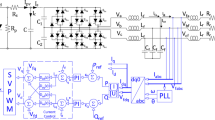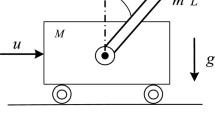Abstract
In this paper, a higher-order sliding mode controller for a power DC–DC converter is proposed. The uncertainty and disturbance are implicit to be unknown. A detailed analysis to explore the local and global stability of a Buck DC–DC converter was presented in this paper. Different control schemes were implemented to regulate the output voltage and to eliminate the high current ripples for the proposed converter, beginning with a proportional-integral-derivative compensation scheme, then a sliding mode controller, a higher-order sliding mode controller and finally an adaptation low with higher-order sliding mode controller (AHOSMC). Stability and robustness of the AHOSMC are proved by using the classical Lyapunov criterion. The sensitivity of parameters variation is analyzed, and a detailed bifurcation analysis is undertaken.









Similar content being viewed by others
Abbreviations
- \(T_{r}\) :
-
Controlled switch (IGBT)
- \(D\) :
-
Uncontrolled switch (diode)
- \(L\) :
-
Inductor
- \(C\) :
-
Capacitor
- \(R\) :
-
Load resistance
- \(r_{L}\) :
-
Equivalent series resistance of \(L\)
- \(r_{c}\) :
-
Equivalent series resistance of \(C\)
- \(i_{L}\) :
-
Inductor current
- \(K_{p}, T_{i}, T_{d}\) :
-
Parameters of the PID controller
- \(r\) :
-
Degree of the sliding surface
- \(I_{s}\) :
-
Load current
- \(T_\mathrm{Req}\) :
-
Equivalent control
- \(H_\mathrm{v}\) :
-
Sensor gain for the output voltage
- \(V_\mathrm{ref}\) :
-
Reference voltage
- \(k\) :
-
Entire number
- \(\vartheta \) :
-
Positive definite matrix
- \(k_{1}\) :
-
Positive gain
- \(V_{e}\) :
-
Input voltage
- \(V_\mathrm{C}\) :
-
Output capacitor voltage
- \(V_\mathrm{rc}\) :
-
Voltage drop across \(r_{C}\)
- \(V_\mathrm{s}\) :
-
Output voltage (the sum of \(V_{C}\) and \(V_\mathrm{rc})\)
- \(\alpha \) :
-
Duty ratio
- \(T\) :
-
Switching cycle
- \(F\) :
-
Switching frequency
- \(T_{R}\) :
-
Switching function which can equal to 1 or 0, the control law
- \(S\) :
-
Sliding surface
- \(\lambda \) :
-
Strictly positive constant
- \(K\) :
-
Positive constant
- \(T_\mathrm{Rn}\) :
-
Stabilizing control
- \(H_{i}\) :
-
Sensor gain for the inductor current
- \(i_\mathrm{ref}\) :
-
Reference current
- \(\sigma \) :
-
Sliding function
- \(v\) :
-
Control law
- \(V\) :
-
Lyapunov function
References
Benbouzid, M., Beltran, B., Amirat, Y., Yao, G., Han, J., & Mangel, H. (2014). Second-order sliding mode control for DFIG-based wind turbines fault ride-through capability enhancement. ISA Transactions, 53(3), 827–833.
Das, M., & Mahanta, C. (2014). Optimal second order sliding mode control for nonlinear uncertain systems. ISA Transactions, 53(4), 1191–1198.
Deane, J. H. B., & Hamill, D. C. (1990). Analysis, simulation and experimental study of chaos in the buck converter. In IEEE proceedings of power electronics, pp. 491–498.
Defoort, M., Floquet, T., Kokosyd, A., et al. (2009). A novel higher order sliding mode control scheme. System & Control Letters, 58(2), 102–108.
Dong, L., & Tang, W. C. (2014). Adaptive backstepping sliding mode control of flexible ball screw drives with time-varying parametric uncertainties and disturbances. ISA Transactions, 53(1), 110–116.
Filippov, A. F. (1964). Differential equations with discontinuous right-hand side. American Mathematical Society Translations, 42, 199–231.
Hadri Hamida, A. (2011). Contribution à l’analyse et à la commande des convertisseurs DC–DC parallèles à PWM. Ph.D. Thesis, University of Biskra, Algeria.
Hadri Hamida, A., Allag, A., Mimoune, S. M., Ayad, M. Y., Becherif, M., Miliani, E., Miraoui, A., & Khanniche, S. (2006). Application of an adaptive nonlinear control strategy to AC–DC-PWM converter feeding induction heating. In IEEE conference on IECON 2006, France, pp. 1598–1602.
Hadri Hamida, A., Zerouali, S., & Allag, A. (2013). Toward a nonlinear control of an AC–DC–PWM converter dedicated to induction heating. In Frontiers in energy. Berlin, Heidelberg: Higher Education Press and Springer, vol. 7, no. 2 pp. 140–145.
Hadri-Hamida, A., Allag, A., et al. (2009). A nonlinear adaptive backstepping approach applied to a three phase pwm AC–DC converter feeding induction heating. ELSEVIER Journals, Communications in Nonlinear Science and Numerical Simulation, 14(4), 1515–1525.
Hadri-Hamida, A., Ghoggal, A., & Zerouali, S. (2014). Bifurcation analysis of a Buck DC–DC converter applied to distributed power systems. International Journal of System Assurance Engineering and Management, SPRINGER Journals, Sweden, 5(3), 307–312.
Li, S., Wang, Z., & Wang, G. (2013). Proportional-integral differential neural network based sliding-mode controller for modular multi-level high-voltage DC converter of offshore wind power. Electric Power Components and Systems, 41(4), 427–446.
Maity, S., Tripathy, D., Bhattacharya, T. K., & Banerjee, S. (2007). Bifurcation analysis of PWM-1 voltage-mode-controlled buck converter using the exact discrete model. IEEE Transactions on Circuits and Systems, 54(5), 1120–1130.
Mattavelli, P., Rossetto, L., Spiazzi, G., & Tenti, P. (1993). General-purpose sliding-mode controller for dc/dc converter applications. In IEEE Proceedings of PESC, pp. 609–615.
Mazumder, S. K., Nayfeh, A. H., & Boroyevich, D. (2001). Theoretical and experimental investigation of the fast- and slow-scale instabilities of a DC–DC converter. IEEE Transactions on Power Electronics, 16(2), 201–216.
Middlebrook, R. D., & Cuk, S. (1977). A general unified approach to modelling switching DC to DC converters in discontinuous conduction mode. In IEEE power electronic specialists conference, pp. 36–57.
Mondal, S., & Mahanta, C. (2013). Adaptive integral higher order sliding mode controller for uncertain system. Journal of Control Theory Applications CAS and Springer, Berlin, Heidelberg, vol. 11, no. 1, 61–68.
Mondal, S., & Mahanta, C. (2011). Nonlinear sliding surface based second order sliding mode controller for uncertain linear systems. Communications in Nonlinear Science and Numerical Simulation, 16(9), 3760–3769.
Nayfeh, A. H., & Balachandran, B. (1995). Applied nonlinear dynamics. New York: Wiley.
Ramash Kumar, K., & Jeevananthan, S. (2012). Analysis, design, and implementation of hysteresis modulation sliding-mode controller for negative-output elementary boost converter. Electric Power Components and Systems, 40(3), 292–311.
Rosehart, W. D., & Cañizares, C. A. (1999). Bifurcation analysis of various power system models. International Journal of Electrical Power & Energy Systems, 21(3), 171–182.
Song, Z., & Sun, K. (2014). Adaptive backstepping sliding mode control with fuzzy monitoring strategy for a kind of mechanical system. ISA Transactions, 53(1), 125–133.
Tan, S. C., Lai, Y. M., Cheung, M. K. H., & Tse, C. K. (2004). An adaptive sliding mode controller for buck converter in continuous conduction mode. In IEEE proceedings of exposition APEC, pp. 1395–1400.
Tan, S. C., Lai, Y. M., Tse, C. K., & Cheung, M. K. H. (2004). A pulse-width modulation based sliding mode controller for buck converters. In IEEE Proceedings of PESC’04, pp. 3647–3653.
Tan, S. C., Lai, Y. M., Cheung, M. K. H., & Tse, C. K. (2005). On the practical design of a sliding mode voltage controlled buck converter. IEEE Transactions on Power Electronics, 20(2), 425–437.
Tan, S. C., Lai, Y. M., Tse, C. K., & Martin, M. K. H. (2006). Adaptive feedforward and feedback control schemes for sliding mode controlled power converters. IEEE Transactions on Power Electronics, 21(1), 182–192.
Tsai, J.-F., & Chen, Y.-P. (2007). Sliding mode control and stability analysis of buck DC–DC converter. International Journal of Electronics, 94(3), 209–222.
Tsang, K. M., & Chan, W. L. (2008). Non-linear cascade control of DC/DC buck converter. Electric Power Components and Systems, 36(9), 977–989.
Tse, C. K., & Adams, K. M. (1992). Quasi-linear modeling and control of DC/DC converters. IEEE Transactions on Power Electronics, 7(2), 315–323.
Utkin, V. I., & Young, K. K. D. (1978). Methods for constructing discontinuity planes in multidimensional variable structure systems. Automatic Remote Control, 39, 1466–1470.
Utkin, V. I. (1992). Sliding mode in control and optimization. Berlin: Springer.
Utkin, V., Guldner, J., & Shi, J. X. (1999). Sliding mode control in electromechanica systems. London: Taylor and Francis.
Venkataramanan, R., Sabanoivc, A., & Cuk, S. (1985). Sliding mode control of DC-to-DC converters. In IEEE Proceedings of IECON, pp. 251–258.
Wang, H. O., Chen, D. S., & Bushnellt, L. G. (2000). Dynamic feedback control of bifurcations. In IEEE proceedings of decision and control, pp. 1619–1624.
Wiggins, S. (1990). Introduction to applied nonlinear dynamical systems and chaos. New York: Springer.
Zhang, C., Wang, J., Li, S., Wu, B., & Qian, C. (2015). Robust control for PWM-based DC–DC buck power converters with uncertainty via sampled-data output feedback. IEEE Transactions Power Electronics,30(1).
Author information
Authors and Affiliations
Corresponding author
Appendix
Appendix
1.1 PID and SMC Controllers
We have introduced firstly a PID feedback controller which has the following transfer function:
Then, we have presented the SMC controller. In SMC, the trajectory of the system is constrained to move or slide along a predetermined hyper plane in the state space. Such mode is completely robust and independent of parametric variations and disturbances (Utkin 1992; Song and Sun 2014). By eliminating the parasitic effect of the capacitor (\(r_{C} = 0\)), The system is described by the following state-space equations (Mondal and Mahanta 2013):
where the matrices F and G are given by:
And S(x) is the measured output function known as the sliding variable. The general form of S(x) is given as follows (Utkin 1992):
It is the first convergence condition which permits dynamic system to converge toward the sliding surfaces. It is a question of formulating a positive scalar function \(\hbox {V(x) }> 0\) for the system states variables which are defined by the following Lyapunov function (Utkin et al. 1999; Filippov 1964):
Now, we define
where \(T_\mathrm{Req}(t)\) and \(T_{Rn}(t)\) represent the equivalent control (Utkin 1992) and the nonlinear switching control and:
The sliding surfaces are given by the following expression (Table 1):
and consequently, their derivatives are given by:
where \(x = [i_{L} \quad V_\mathrm{C}]^{ T}\),
and
Finally, the control law is given by:
1.2 Parameters of the Buck DC–DC Converter
1.3 How to Plot a Bifurcation Diagram?
Let us consider the state equation:
The diagram of bifurcation of this system is defined in the following way: One represents \(V_{e}\) in X-coordinate (\(V_{e}\) ranging between 15 and 50 V), and we present in ordinate, the values obtained by the solution of the state equation, after a certain iteration count (400 for example). For each value of \(V_{e}\), the operation is started again a great number of times by choosing each time a random value of the first term \(x_{0}\) (equilibrium values). One thus obtains the bifurcation diagram of our system.
Rights and permissions
About this article
Cite this article
Hadri-Hamida, A. Higher-Order Sliding Mode Control Scheme with an Adaptation Low for Uncertain Power DC–DC Converters. J Control Autom Electr Syst 26, 125–133 (2015). https://doi.org/10.1007/s40313-015-0168-4
Received:
Revised:
Accepted:
Published:
Issue Date:
DOI: https://doi.org/10.1007/s40313-015-0168-4




